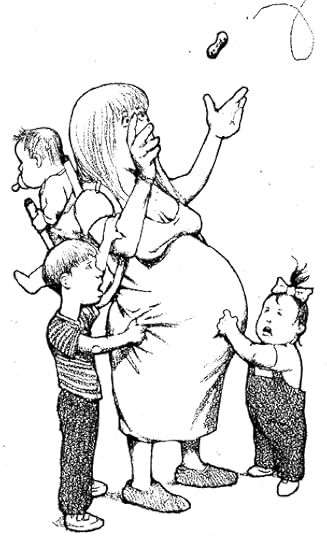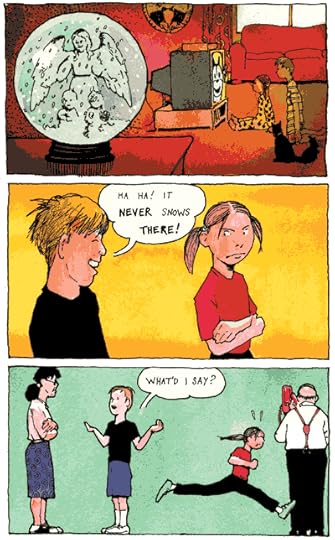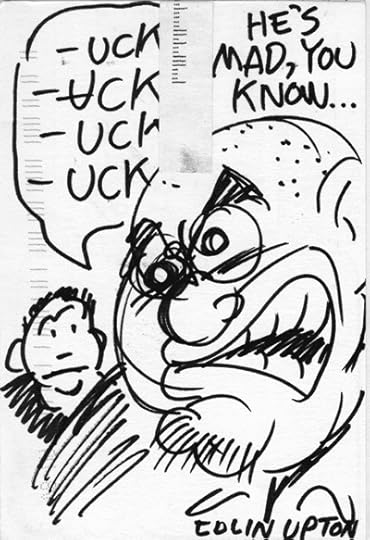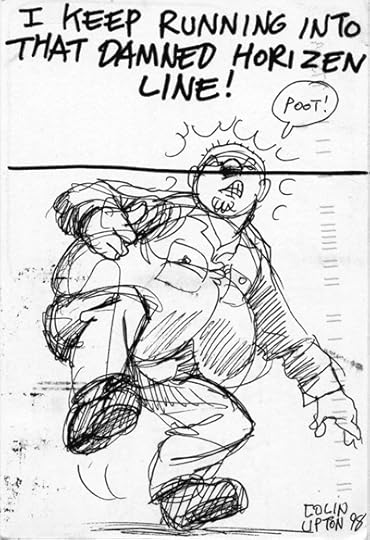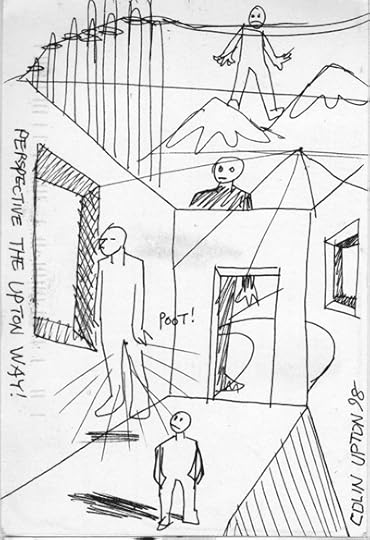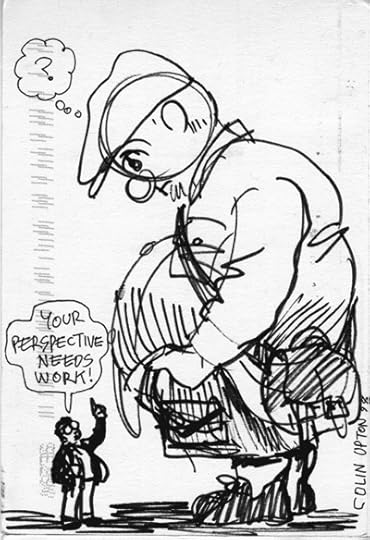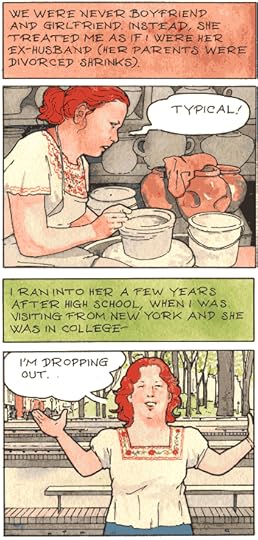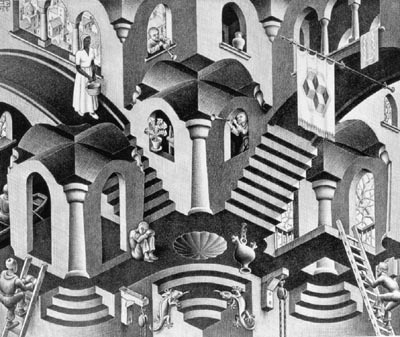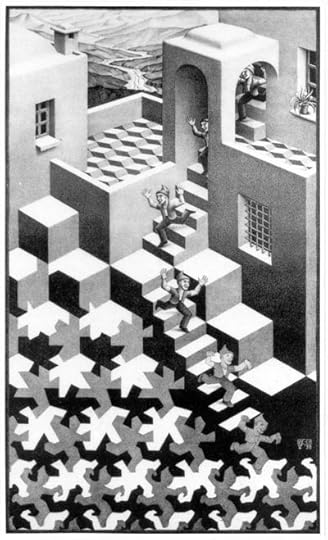David Chelsea's Blog, page 49
March 2, 2011
A Model Family 2
Following up on my blog post of a few months ago, here are more examples of illustrations in which I used my wife Eve, son Benjamin and daughter Rebecca as models, (not always with their consent).

Illustration for Portland Tribune, 2001
The earliest is a Portland Tribune piece from 2001 when Rebecca was still a babe in arms. To make single mom Eve seem even more burdened, I augmented the family with a couple of extras- a middle daughter and one on the way.

Illustration for New York Observer

Illustration for Modern Love column, 2008
I made frequent use of the family as models for the Modern Love columns I illustrated in the New York Times. The piece with the jilted suitor is a true family production; those are my fingers being slammed in the door, the hands slamming it belong to Eve and Rebecca, and it can only have been Ben snapping the reference photo.

Illustration for Modern Love column, 2007
In another Modern Love piece Rebecca switches sexes to portray a boy obsessed with penguins.

Illustration for Modern Love column, 2007
For the last piece, done in 2007, Ben and Rebecca were too old to model for the toddlers in the story about a military wife who tries to make do with "Flat Daddy", a cardboard cutout of her absent husband; but photographs pulled from a family album enabled them to appear anyway.

Storyboard, 2007
The entire family appears in this storyboard for a car ad. You can tell it's a few years old; Ben is now taller than me.
Page from 24 Hour Comic, 2005
Ben and Rebecca make occasional appearances in my comics as well. In the 24 hour comic we are playing a family game where one member thinks of a name and the others have to guess it; "before" and "after" refers to where the guess falls alphabetically.
Panels from "Snow Angel", story for Dark Horse Presents
"Snow Angel" is a story I first drew as a 24 hour comic in 2007 and since reworked in color for the anthology Dark Horse Presents. The heroine is not named, but she is pretty clearly based on Rebecca, so much so that when I drew the character again in a 24 hour comic last year, I found that she had grown taller along with Rebecca. Her annoying older brother is pretty clearly Ben as well, but for some reason I did give them different parents.
March 1, 2011
Master Of My Domain Name

The Other David Chelsea
When I launched this website two and a half years ago (with the very able help of Brad Smith and his crew at Hot Pepper Studios) I naturally intended to put my name on it, only to find that the web address davidchelsea.com was already taken, by an Italian porn actor with the same name. Who knew? I had no choice but to settle for the more generic but available dchelsea.com, as well as a few variants like davidchelseainlove.com, and so it has been ever since. Well, good news- a few days ago my friend Jacob Mercy informed me that my namesake had relinquished his hold, and the domain name was once again available. One credit card payment to Godaddy.com later, the name was mine.
David Chelsea fans looking for my site can now skip Google and type my name directly in the address bar. What has become of the other David Chelsea is not known; but a Google search lists his "active years" as between 2002 and 2007, so presumably he is retired and has no further need of a website. My apologies to any Douglas, Donald, Daphne or Delia Chelseas out there, but I am hanging on to dchelsea.com as well; at this point the name is too firmly established to give up, and it's the one listed in the bio in my new book Extreme Perspective!
February 28, 2011
Can't Stop The Girl With The Keyhole Eyes
Three more frames from "The Girl With The Keyhole Eyes", an upcoming comics story for Dark Horse Presents.
February 15, 2011
Extreme Perspective Day!
Today, February 15th, 2011, is the official publication date for my new book Extreme Perspective! For Artists: Learn the Secrets of Curvilinear, Cylindrical, Fisheye, Isometric, and Other Amazing Systems that Will Make Your Drawings Pop Off the Page. Theoretically, you can walk into your nearest bookstore and buy a copy today. In the meantime, here's a review worth reading by Johanna Draper Carlson from the website Comics Worth Reading.
February 12, 2011
Prospettiva!
The publication date for Extreme Perspective!, my new book from Watson-Guptill, approaches. Presumably it will be in stores on or after February 15th, but in the meantime you can pre-order on Amazon. Meanwhile, my previous book Perspective! is now available in an Italian language edition from Turin publisher Vittorio Pavesio. I haven't seen a copy yet, but the preview page below appears on the publisher's website.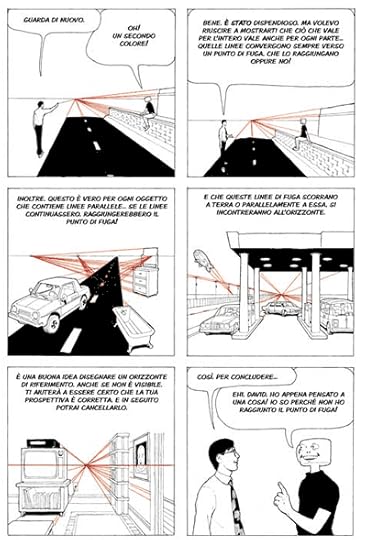
February 10, 2011
Letters To David
I've been doing a lot of posts lately about envelopes I've sent to friends over the years, and I thought it also might be fun to show some that I've received. All of these examples are from the 20th Century- I'm still in touch with all of these people, but the Internet Age has put an end to the snail letter.
When l shared an apartment in New York with my high school friend Tim Hill, another school friend, Will Spray, sent envelopes depicting us both. Will put a self-portrait on the back of one.
Another school friend penpal, Caitlin Maynard.
The above two letters are from yet another school friend, Norelle "Zook" Pratt.
A friend I knew in New York, Tasha Vinikow, kept up a correspondence after she married and moved to Washington.
For a while my most prolific correspondent was former college roommate Will Schroeder, whose envelopes overflow with cartoons as well as scribbled thoughts that must have come to him after he sealed the flap.
Hardly any of the professional artists I've exchanged letters with decorate their correspondence the way I do; one exception is Toronto cartoonist Colin Upton. In this series of postcards Colin twits my pretensions to being a perspective know-it-all.
February 9, 2011
Commercial Announcement!
Notice to potential commercial clients and other people who love storyboards: I have long had storyboard samples on this site, but I just added an extensive portfolio with more recent examples to the Comics Lifestyle website. You can view the album here. Feel free to visit often- I'll be adding more to it from time to time.
February 6, 2011
Still plugging away at "The Girl With The Keyhole Eyes"
February 5, 2011
Isometric Exercises: Great Minds Think Alike

Detail from "Playtime" by Joe Matt
Following up on the recent post about my own illustration and comics drawn using isometric projection, here is a survey of work by other artists using isometric methods (not all of which conforms strictly to formula, but these guys are cartoonists, illustrators, photographers and fine artists, not architectural draftsmen).
The great Dutch artist M.C. Escher exploits the visual ambiguity inherent in isometric in this symmetrical but discordant composition. The left half of the scene is an overhead view, and the right half is seen from underneath. By the way, according to strict isometric construction, the buildings seen through the window at upper left should be at the same scale as the architecture in the foreground. Escher undoubtedly knew the rule, but chose to disregard it- or perhaps we are seeing a miniature through the window?
Here Escher combines a perspective top half shading imperceptibly into an isometric bottom half. The isometric cube pattern serving as floor tiles is a clever touch.
"Gasoline Alley" creator Frank King specialized in spectacular Sunday pages, including this backyard scene.
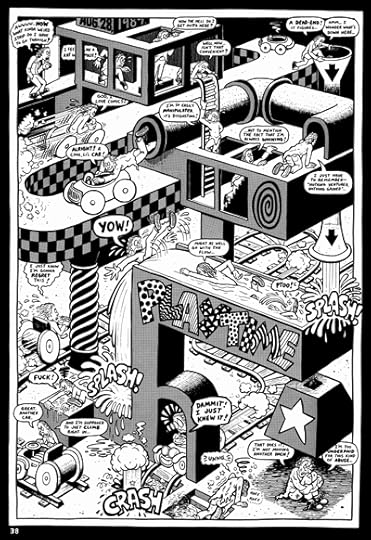
"Playtime" by Joe Matt
Autobiographical cartoonist Joe Matt usually documents his love life, but here he puts himself through an isometric obstacle course.
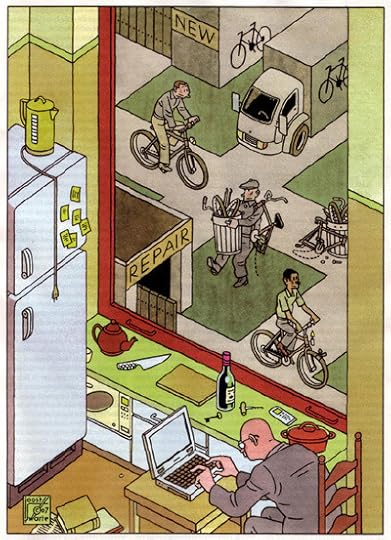
Illustration by Joost Swarte
Like Escher, Dutch cartoonist Joost Swarte bends the rules when he sees fit; the lines in this illustration follow isometric angles, but the figures seen out the window are at a smaller scale than the man at the table.

New Yorker cover by Chris Ware
"Jimmy Corrigan" cartoonist Chris Ware hardly ever uses perspective; instead he favors a variety of paraline drawing methods, including isometric.
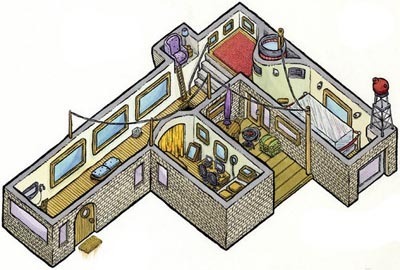
Illustration by Scott Teplin
New York illustrator Scott Teplin mixes meticulous rendering with visual wit. This tidy apartment doubles as the letter 'F'.

Photograph by Scott McCloud
Photographs can have an isometric appearance, provided they are taken with a sufficiently powerful long-distance lens tipped at the right angle. This shot of Toronto by Understanding Comics author Scott McCloud would not look out of place in "The Sims".
January 31, 2011
Letters To Amy, Part Two
Here are more decorated envelopes sent to my friend Amy Schoppert over the years. In addition to the usual raunchy nudes and portraits of movie stars (Buster Keaton) and friends (manic East Village poet Matthew Courtney) this batch includes some pieces that push the envelope of what can be sent through the mail, like the round envelope up top and another on sandpaper (I remember it wasn't easy to get the stamp to stick to that one).
The photo collage is in 3-D- just cross your eyes until the duplicate images fuse.
Sometimes one doesn't have time to draw something from scratch: here I pasted in an early sketchbook version of a scene from my first book David Chelsea In Love.
This 6 inch wide envelope contains a bumper crop of tiny penciled faces. No need to guess at the date- the enlarged detail below shows 1980 Presidential candidates Ronald Reagan, Jimmy Carter and third party guy John Anderson.
David Chelsea's Blog
- David Chelsea's profile
- 8 followers


